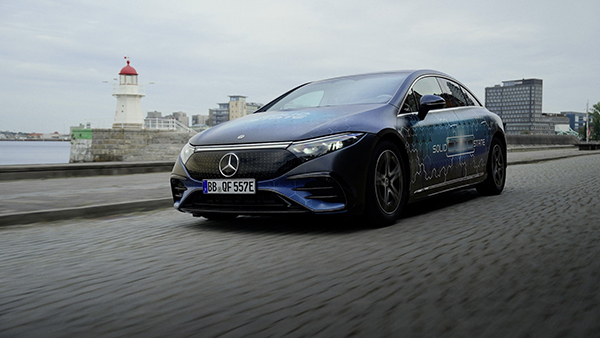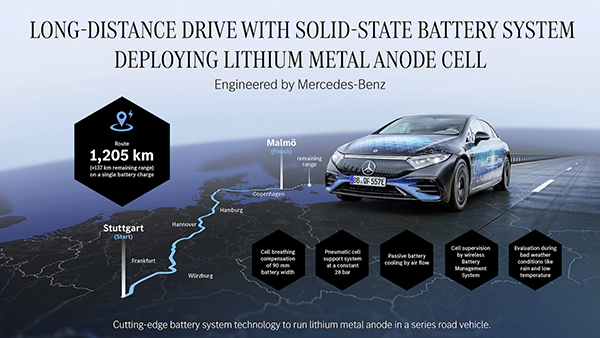Mercedes-Benz is once again pushing the boundaries of what’s possible with solid-state batteries. A lightly modified EQS test vehicle equipped with next-generation battery technology completed an extraordinary journey: 1,205 kilometers (748.7 miles) on a single charge.

The Mercedes EQS traveled from Stuttgart, Germany, through Denmark, and finally arrived in Malmo, Sweden. The luxury sedan rolled into Malmo with 137 kilometers (85 miles) of range still in reserve, making the theoretical maximum driving distance a remarkable 1,342 kilometers (833.8 miles).
This achievement demonstrates that breakthroughs in battery chemistry are no longer confined to labs and prototypes. Instead, they are proving themselves in real-world conditions, on public roads, across varied climates and traffic scenarios.
For electric vehicle owners and skeptics alike, it is a bold signal that the age of “range anxiety” may finally be drawing to a close. The record-setting drive was part of a broader validation program for solid-state battery technology at Mercedes-Benz.
Since announcing real-world testing earlier this year, engineers have been putting the technology through its paces in Stuttgart facilities and now out on European highways.
The journey north covered the A7 and E20 corridors, bypassing ferries, and relying on the car’s “Electric Intelligence” navigation to optimize the route. This system factored in elevation changes, traffic, and even energy demands for heating and cooling.
By completing the long-haul trip without a single charging stop, the EQS surpassed the benchmark set by Mercedes’ own Vision EQXX research vehicle, which had achieved a 1,202-kilometer run between Stuttgart and Silverstone in 2022.
The EQS’s 1,205-kilometer result not only nudged past that figure but did so in a vehicle much closer to production readiness. At the heart of this success is the lithium-metal solid-state battery, jointly developed with Mercedes-AMG High Performance Powertrains (HPP), the same division responsible for the company’s Formula 1 engines.
The battery cells themselves come from Factorial Energy, a U.S.-based company specializing in solid-state technology, using its proprietary FEST (Factorial Electrolyte System Technology) platform.
Unlike conventional lithium-ion batteries, solid-state cells replace the liquid electrolyte with a solid material, unlocking higher energy density and improved safety.
In the EQS test car, usable energy content increased by about 25%, yet the pack remained comparable in size and weight to the standard production battery. This is a critical leap forward: more energy stored without making the battery bulkier or heavier.
To manage one of the challenges of solid-state chemistry, which is volume changes during charging and discharging, the EQS prototype used pneumatic actuators that apply consistent pressure to the cells.

The result is a battery system that can endure repeated cycles while maintaining performance and efficiency. Cooling is handled passively via airflow, further reducing complexity and weight.
Markus Schäfer, Chief Technology Officer of Mercedes-Benz, called the solid-state breakthrough a “game-changer” and emphased that the company’s goal is to bring the technology to series production by the end of the decade.
If successful, customers could see luxury EVs with ranges well beyond 1,000 kilometers, combined with faster charging times and improved durability.
The implications for drivers are enormous. Instead of planning trips around charging stops, vehicles like the EQS prototype could offer the freedom to cross multiple countries in one stretch, just as the Stuttgart-to-Malmo run demonstrated.
Such long legs would make EVs not only competitive with combustion vehicles but potentially superior in terms of convenience. Solid-state technology has long been touted as the answer, but until recently, it has remained more of a promise than a practice.
The EQS’s achievement comes at a time when automakers worldwide are racing to overcome the barriers that still hinder mass EV adoption: limited range, long charging times, and the environmental cost of battery production.
By proving that a solid-state-battery-powered EQS can handle more than 1,200 kilometers in real-world driving, Mercedes-Benz has provided one of the clearest validations yet that the technology is ready to move from prototype to production.
The Mercedes EQS in the U.S.
The Mercedes-Benz EQS Sedan arrived at dealerships across the United States in the fall of 2021 as the first model of Mercedes’ electric sub-brand, EQ, in North America.
While it might take a while before the EQS equipped with solid-state batteries hit the market, the luxury sedan starts at $104,000 on the U.S. market. The base version is the EQS 450+ with 355 horsepower and 419 pound-feet of torque.
Its dual-motor powertrain propels the car from 0 to 60 mph (0 to 97 kph) in 5.9 seconds. This version features a 118-kWh battery pack for an EPA-estimated electric range of 390 miles (628 kilometers).
At the opposite end of the range sits the EQS 580 4MATIC with 536 horsepower and 633 pound-feet of torque for a run from 0 to 60 mph in just 4.2 seconds. The same 118-kWh battery pack stores enough energy for a drive of up to 371 miles (597 kilometers) before the car needs to be plugged in again.
Mercedes-Benz EQS Travels Impressive Distance On A Single Charge
12/09/2025
No Comments
Mercedes-Benz | Mercedes-AMG
Click to rate this post
[Total: 1 Average: 5]